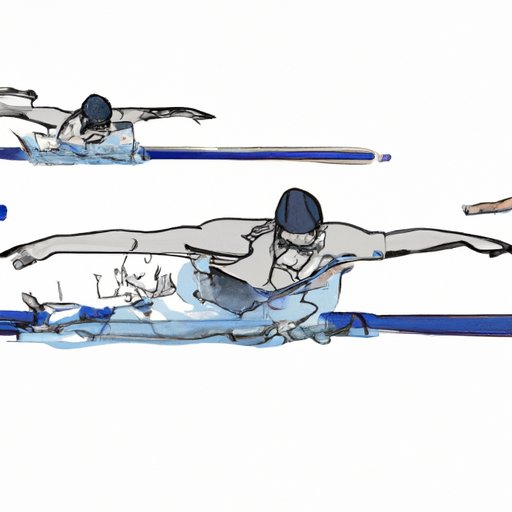
Introduction
Swimming is not only a refreshing activity but is also an excellent full-body workout. This low-impact exercise is great for anyone looking to improve their cardiovascular fitness, tone their muscles, and relieve stress.
If you’ve never swum before, getting started may seem intimidating. But with the right guidance and a positive attitude, you can dip your toes in the water and start reaping the benefits of swimming for exercise. In this guide, we’ll cover everything you need to know to get started, from finding a pool to mastering different strokes.
The Benefits of Swimming for Exercise and How to Get Started: An Introductory Guide
Swimming is an excellent form of exercise that offers numerous benefits for people of all ages and fitness levels. Not only does it provide a low-impact cardiovascular workout, but it also improves muscle strength and flexibility. Additionally, swimming is a great way to reduce stress and improve mental health.
If you are interested in adding swimming to your fitness routine, the first step is finding a pool. Many local recreation centers have indoor and outdoor pools that are open to the public. Some gyms and fitness centers also have pools for their members.
If you’re feeling uncertain about your abilities in the water, don’t let that stop you. You can take swimming classes to learn proper technique and gain confidence. There are a variety of classes available, including group instruction and one-on-one sessions with a coach.

How to Overcome Fear and Anxiety When Beginning a Swimming Routine for Exercise
Starting a new activity can be nerve-wracking, and swimming is no exception. Fear of drowning and claustrophobia are common barriers that prevent people from taking the plunge. However, there are practical steps you can take to overcome these fears and anxieties.
One way to ease into swimming is to gradually adjust to the water. Start by wading in the shallow end and gradually move to deeper water. When you feel comfortable, practice floating or treading water. You can also practice breathing techniques to help you relax in the water.
Another option is to take swimming lessons. A qualified instructor can guide you through the skills you need to become comfortable in the water and improve your technique.
The Importance of Proper Form and Technique in Swimming for Exercise
Proper form and technique are essential for getting the most out of your swimming workouts. Not only do they help you avoid injuries, but they also help you move more efficiently through the water.
One of the most important aspects of swimming technique is maintaining a streamlined body position. This means keeping your body straight and horizontal, with your hips at the surface of the water. You’ll also want to maintain proper breathing technique, which involves exhaling while underwater and inhaling when your face is above water.
If you are new to swimming, consider taking lessons to learn proper technique. Additionally, swimming drills can help you improve your swimming form and become more efficient in the water.
A Comprehensive Guide to Building Stamina When Swimming for Exercise
As with any exercise, building stamina is key to getting the most out of your swimming workouts. Begin by gradually increasing your workout times. Start with a few laps at a time, and gradually work your way up to longer sessions.
Incorporating interval training is another great way to improve your swimming endurance. Try swimming at a faster pace for short bursts followed by a short rest period, then repeat. This type of training helps improve both your aerobic and anaerobic endurance.
Keeping your swimming workouts varied will also help improve your stamina. You can try different stroke styles, or use cardiovascular equipment like kickboards to focus on specific muscle groups.
How to Set Realistic Goals and Track Your Progress While Swimming for Exercise
Setting goals is an excellent way to keep yourself motivated and help track your progress. Start by choosing goals that are both achievable and measurable. You may want to aim for a certain distance, number of laps, or time in the pool.
A swim tracker app or journal can help you stay on track with your goals. Logging your workouts and tracking your progress can help you identify areas where you need improvement and help you adjust your routine accordingly. Don’t forget to celebrate your progress along the way!
Understanding the Different Types of Swimming Strokes and Their Impact on Your Workout
There are several different swim strokes to choose from, each with its unique benefits and challenges.
The freestyle stroke is the most common and efficient stroke style. It primarily works the shoulders, back, and arms while engaging the core muscles in the process.
The breaststroke is another popular stroke that primarily works the chest and arms. It is less taxing on the shoulders than the freestyle but requires more coordination and timing to master.
The backstroke is done while lying on the back, and it is great for building back and shoulder muscles. Unlike other strokes, it also offers a chance to refine breathing techniques since the face is always out of the water.
The butterfly stroke is the most challenging to master and is not recommended for beginners. It requires strength and coordination to execute correctly.
Tips and Tricks for Maintaining a Swimming Routine for Exercise and Staying Motivated
Consistency is key when it comes to keeping up with a swimming routine, but that doesn’t mean it always has to be the same. Changing your routine can help keep things fresh and exciting.
You can try different stroke styles or incorporate different equipment, such as pull buoys or paddles, to switch up your routine while targeting different muscle groups.
Another way to stay motivated is to find a swimming partner. Having someone to swim with can make workouts feel less tedious and more enjoyable.
Setting rewards for reaching your goals can also serve as an excellent motivator. You may want to treat yourself to a new swimsuit or a day at the spa when you reach a milestone.
Conclusion
If you are interested in swimming for exercise, the key is to start slow, practice good form, and consistently work to improve your stamina and technique. With patience and perseverance, you can become a confident and proficient swimmer. Find a pool that works for you, get comfortable in the water, and keep practicing.
Regular swimming can significantly improve your physical and mental well-being, making it an excellent addition to any fitness routine.




